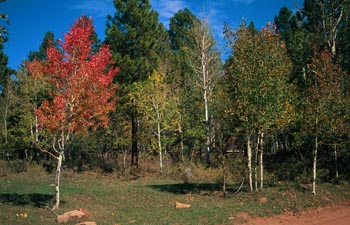Quaking Aspen

Common Name(s):
Quaking Aspen
Aspen
Quakie
Scientific Name:
Populus tremuloides Michx.
Scientific Name Synonyms:
None known
another synonym goes here additional information
Symbol:
POTR5
Description:
Life Span: Perennial
Origin: Native
Season: Cool
Growth Characteristics: Aspen is an attractive deciduous tree, growing up to 40 feet tall. The trunk is generally long and slender, but can be up to nearly 3 feet in diameter. It flowers April to June, and fruits ripen May to July. The tree grows rapidly from basal sprouts and root sprouts. It seldom reproduces from seeds.
Flowers/Inflorescence: Inflorescence is a catkin.
Fruits/Seeds: Fruit is tufted capsules borne in catkins. Range in color from light green to brown. The seeds have very specific conditions needed to germinate, and therefore, under current climatic conditions, seldom produce aspen seedlings that survive.
Leaves: Aspen has alternate leaves, the blades being highly variable, from oval to broadly oval, the top of the leaf coming to a point or being rounded, and the base being round to square. The margins are serrated, with the teeth being mostly rounded. The upper surface of the leaf is dark green with a prominent white midvein. The underside of the leaf is pale green. The petiole is flattened and as long as the leaf. This petiole allows the leaves to "quake" in the wind, hence the name "quakie." The leaves change from green to bright yellow or yellowish-orange in the fall.
Stems: Twigs are slender, reddish-brown to gray. The trunk bark is thin, smooth, and chalky white. The bark becomes darker and breaks into blocks or plates with age or damage (i.e. fire, carving).
Ecological Adaptions:
Quaking aspen occurs on a wide variety of sites. It grows on moist uplands, dry mountainsides, high plateaus, mesas, avalanche chutes, talus, parklands, gentle slopes near valley bottoms, alluvial terraces, and along watercourses. It is most common at elevations between 6,000 and 10,000 feet. Most of the reproduction of Aspen is by root-sprouting, many trees in a grove being connected together by a common root system in what are referred to as "clones." Because the trees are in clones, they are genetically identical. This species is not shade tolerant, and entire clones can be lost due to the encroachment of spruce and fir into this type of ecosystem. Aspen is dependant on fire, clear cutting, or other "clearing" disturbance to keep stands open, free of conifers, and reproducing from suckers.
Soils: Quaking aspen grows on soils ranging from shallow and rocky to deep loamy sands and heavy clays. Good quaking aspen sites are usually well-drained, loamy, and high in organic matter and nutrients.
Associated Species: Mountian brome, snowberry, blue wildrye, larkspur, waterleaf, Rocky Mountain maple, and chokecherry.
Uses and Management:
Aspen's main uses in Utah have been for fence poles and buildings, and as firewood. Some trees have been sawed into lumber or pulp. Recently, it has been used for paneling.
Aspen is good to excellent forage for sheep, and fair for cattle. The twigs, bark, and buds are browsed by wildlife and birds eat the seeds. Grazing of aspen sprouts, especially by cattle and elk, is a growing concern in the maintenance of aspen stands.
Wild and domestic ungulates use quaking aspen for summer shade. Seral quaking aspen communities provide excellent hiding cover for moose, elk, and deer. Deer use quaking aspen stands for fawning grounds.
Well-stocked quaking aspen stands provide excellent watershed protection. The trees, the shrub and herbaceous understories, and the litter of quaking aspen stands provide nearly 100 percent soil cover. Soil cover and the intermixture of herbaceous and woody roots protect soil except during very intense rains. Quaking aspen intercepts less snow and transpires less water than conifers, so snowpack and runoff is greater under quaking aspen.
Quaking aspen is valued for its aesthetic qualities at all times of the year. The yellow, orange, and red foliage of autumn particularly enhances recreational value of quaking aspen sites.
The bark of quaking aspen was used by pioneers and American Indians as a fever remedy, as well as for scurvy. It contains salicin (similar to the active ingredient in aspirin). A substance similar to turpentine was extracted and used internally as an expectorant and externally as a counterirritant.

